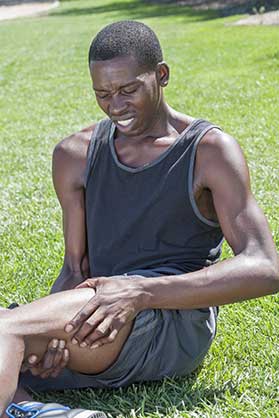Hamstring Injury Treatment in Midland Park, NJ

The hamstring, a group of three muscles - semitendinosus, semimembranosus, and biceps femoris - that run along the back of your thigh, allows you to bend your leg at the knee. A hamstring can become injured when you suddenly pull or strain one or more of your hamstring muscles beyond its capacity, causing the muscle to stretch or tear. Hamstring injuries are among the most common sports injuries, with pain ranging from mild to severe. Hamstring injuries most commonly affect athletes whose sport include frequent sprinting, such as in track, soccer, baseball and football.
Consult a hamstring injury specialist to get back into the game! Call (201) 806-6099 or contact Medwell Orthopedics & Functional Medicine for Men & Women online.
What Causes Hamstring Injuries?
Hamstring muscle strains commonly occur as a result of an “eccentric contraction,” which is when the muscle lengthens as it contracts, or shortens. This happens when you extend a muscle while it is weighted. When athletes sprint, the hamstring muscles contract in an eccentric manner: The back leg straightens, and the toes are used to push off and move forward. The hamstring muscles, which are lengthened quickly to propel the runner forward, are overloaded with body weight.
Hamstring injuries can occur when the muscle is pulled, or when it is partially or completely torn. Most hamstring injuries occur in the thick, central part of the muscle or where the muscle fibers join tendon fibers.
Hamstring Injury Symptoms
You may suffer from a hamstring injury if you find yourself experiencing the following symptoms:
- Sudden or severe pain during exercise, along with a snapping or popping feeling
- Pain in the back of the thigh or lower buttock when walking, straightening the leg or bending over
- Swelling and tendonitis
- Bruising or discoloration along the back of the leg
Hamstring Injury Treatment
Depending on the level of severity associated with the hamstring, the treatment options will vary. Surgical intervention with hamstring injuries, fortunately, is rare, though may be required for severe injuries. When needed, the surgical procedure takes place in order to repair a complete tear within the muscle. This procedure is comprised of the surgeon pulling the hamstring muscle back into place, removing any scar tissue and reattaching the tendon to the bone using large stitches or staples.
Nonsurgical recommendations can start with icing and resting the injury. Your healthcare provider will likely recommend refraining from exercise, lest you face worsening the strain. An elastic compression bandage may be needed to prevent additional swelling and blood loss, and you will likely be instructed to keep the leg elevated in order to further reduce swelling.
To ensure that you are not putting any added pressure on the injury, you may need to wear a knee splint, which will keep your leg in a neutral position and help it heal. Physical therapy, once the initial pain and swelling have subsided, can begin to restore range of motion and strength.
Hamstring injuries, while painful, can be fully recovered from when proper rehabilitation steps are taken. Consulting your primary care provider or sports injury specialist is important to ensure irreparable damage doesn’t occur.
Hamstring Injury Prevention
To help prevent hamstring strain, increasing flexibility and muscle balance is key, and believe it or not, this starts with proper warmups and stretching. Among the safest and easiest hamstring stretches are static hamstring stretches, which don’t require great movement and can be performed either while sitting down or standing. These flexes help release tension and increase flexibility. On the other hand, incorporating yoga and Pilates into your regular stretching routines not only strengthens your hamstring muscles, but also increases your strength and flexibility across all your muscle groups.
Other ways to prevent hamstring injuries include being realistic with your exercise expectations. If it’s been a while since you’ve exercised, it’s important to start slowly; adding intensity to your exercise regimen too quickly is a quick way to strain your muscles. By that same token, if you begin to feel pain in the back of your thigh, you should take a break and let your muscles recuperate; working through the pain can result in injury.
Your hamstrings are among the most important muscles for mobility - don’t disregard the important function they serve by not properly caring for them. While hamstring injuries are among the most common type of injury, they can be prevented.
Request more information about hamstring injury treatment today. Call (201) 806-6099 or contact Medwell Orthopedics & Functional Medicine for Men & Women online.
Medwell Orthopedics & Functional Medicine for Men & Women
Address
33 Central AveMidland Park, NJ 07432
(201) 806-6099
www.BergenCountyDoctors.com
Hours
Mon:
8:00 am - 8:00 pm
Tue:
2:00 pm - 7:00 pm
Wed:
8:00 am - 6:30 pm
Thu:
8:00 am - 1:00 pm
Fri:
8:00 am - 6:30 pm
Sat:
9:00 am - 1:00 pm
Sun:
By Appointment Only

